Grossnick Roy A. United States Naval Aviation, 1910-1995
Подождите немного. Документ загружается.

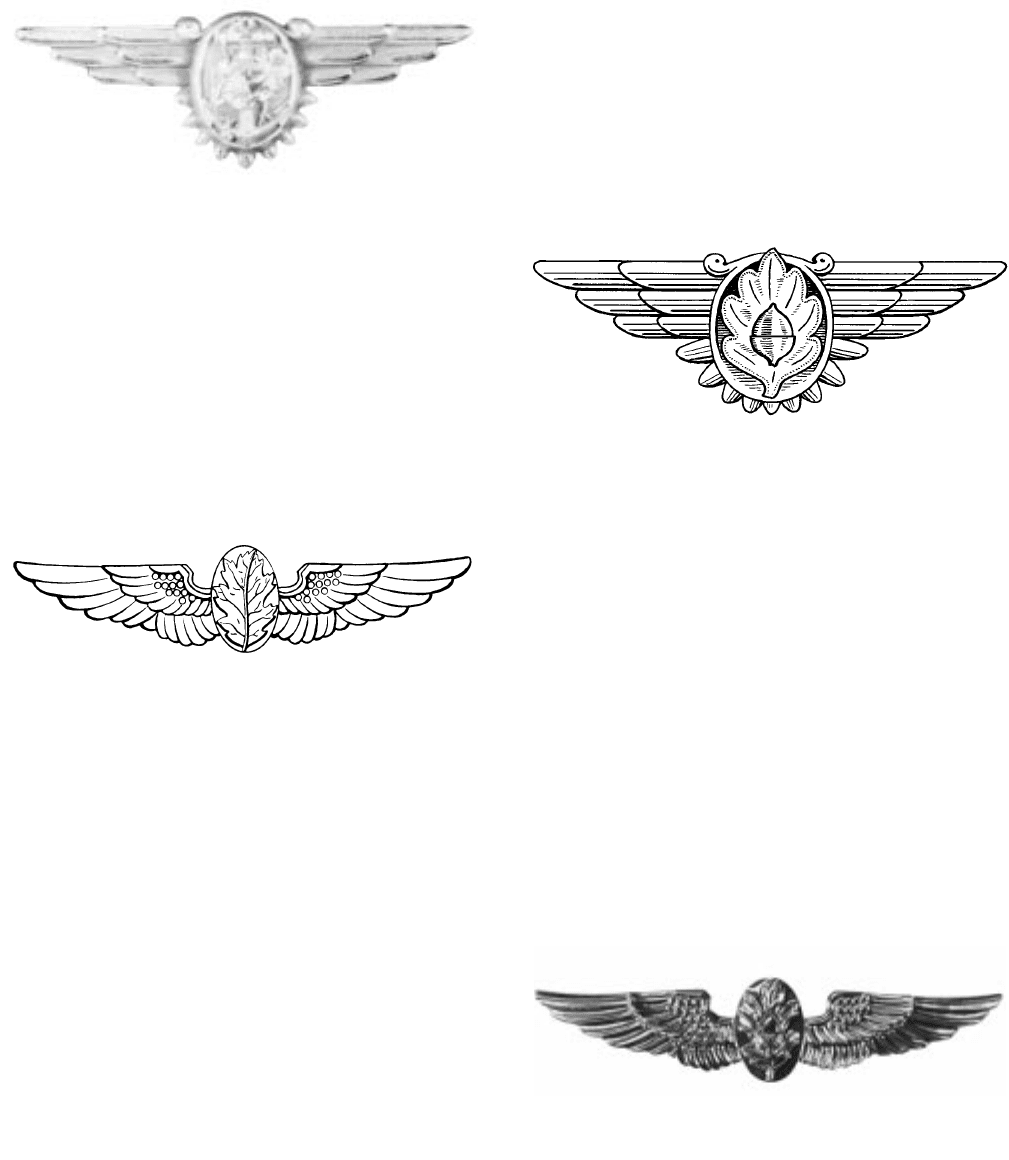
symbol of Medical Corps insignia. The metal pin
shall be of dull finish. Dimensions: 2
3
⁄4 inches be-
tween wing tips, central device 1 inch in vertical di-
mension to lower edge of fringe. Lateral width of
oval crest,
3
⁄4 inch. Oak leaf
7
⁄8 inch in length,
9
⁄16 inch
in width, to be vertically mounted surcharged on
oval. Silver acorn
3
⁄8 inch in length surmounted on
oak leaf.” A Navy Press Release issued a few days
earlier, on 27 July 1942, gave the following descrip-
tion: “It will consist of wings which are a modifica-
tion of the Perian Feroher with a central design con-
sisting of convex oval crest with appropriate scroll
and rounded edge. The central device is to be sur-
charged with the gold leaf and silver acorn that
serves as the Medical Corps symbol.”
dimension and
7
⁄160 in width; oak leaf
13
⁄320 in length,
7
⁄320
in width, to be diagonally mounted surcharged on the
anchor; silver acorn
1
⁄80 in length surmounted on oak
leaf.” The insignia described above was to be worn
until the designation “Flight Nurse” was revoked.
On 11 August 1952, the Secretary of the Navy ap-
UNITED STATES NAVAL AVIATION 1910–1995 661
This photograph shows the Flight Nurse Wings as approved in 1945.
proved a revision to the Flight Nurse Insignia. The
BuPers Change Memo 1-2 of 6 February 1953 de-
scribed the new Flight Nurse Insignia as: “The insignia
shall consist of a gold color metal pin of the same de-
sign as that prescribed for Flight Surgeons...except
that the acorn shall be omitted, and the width be-
tween wing tips shall be 20; oval width
15
⁄320 vertical
and
5
⁄160 horizontal axis; thickness at leaf center,
1
⁄8.0
This line drawing depicts the Flight Nurse Wing Insignia that was ap-
proved in 1952.
Flight Surgeon Wing Insignia
On 18 May 1942, the Chief of Naval Personnel ap-
proved an insignia for Naval Flight Surgeons. A
BuPers Circular Letter Number 107-42 of 29 July
1942 announced changes to the 1941 Uniform
Regulations. These changes, as approved by the
Secretary of the Navy, included the establishment of
the new Flight Surgeon wings. The change to the
Uniform Regulations read as follows: “Officers of the
Medical Corps who have qualified as Naval Flight
Surgeons shall wear the following insignia on the
left breast: A gold plated metal pin, winged, with
slightly convex oval crest, with appropriate em-
bossed rounded edge and scroll. The central device
to be surcharged with gold oak leaf and silver acorn,
This line drawing depicts the Flight Surgeon Wings approved in 1942.
On 11 August 1952, the Secretary of the Navy ap-
proved a major revision to the Flight Surgeon wings.
The new design superimposed the Medical Corps de-
vice (gold oak leaf and silver acorn) on the style of
wings used for the Naval Aviator wing insignia.
BuPers Memo 1-2 of 6 February 1953 and the change
to the 1951 Uniform Regulations describes the new
design for Flight Surgeon wings as follows: “A gold
embroidered or gold color metal pin; winged; with an
oval center design upon which the Medical Corps de-
vice (a gold oak leaf and silver acorn) is superim-
posed. Width between tips of wings shall be 2
3
⁄40; oval
with
5
⁄80 vertical and
13
⁄320 horizontal axis; thickness
with acorn
3
⁄160; acorn and cup
7
⁄320 long; acorn width
1
⁄80; cup depth 1
1
⁄160; cup width
11
⁄640.”
This photograph shows the Flight Surgeon Wings that were approved
in 1952.
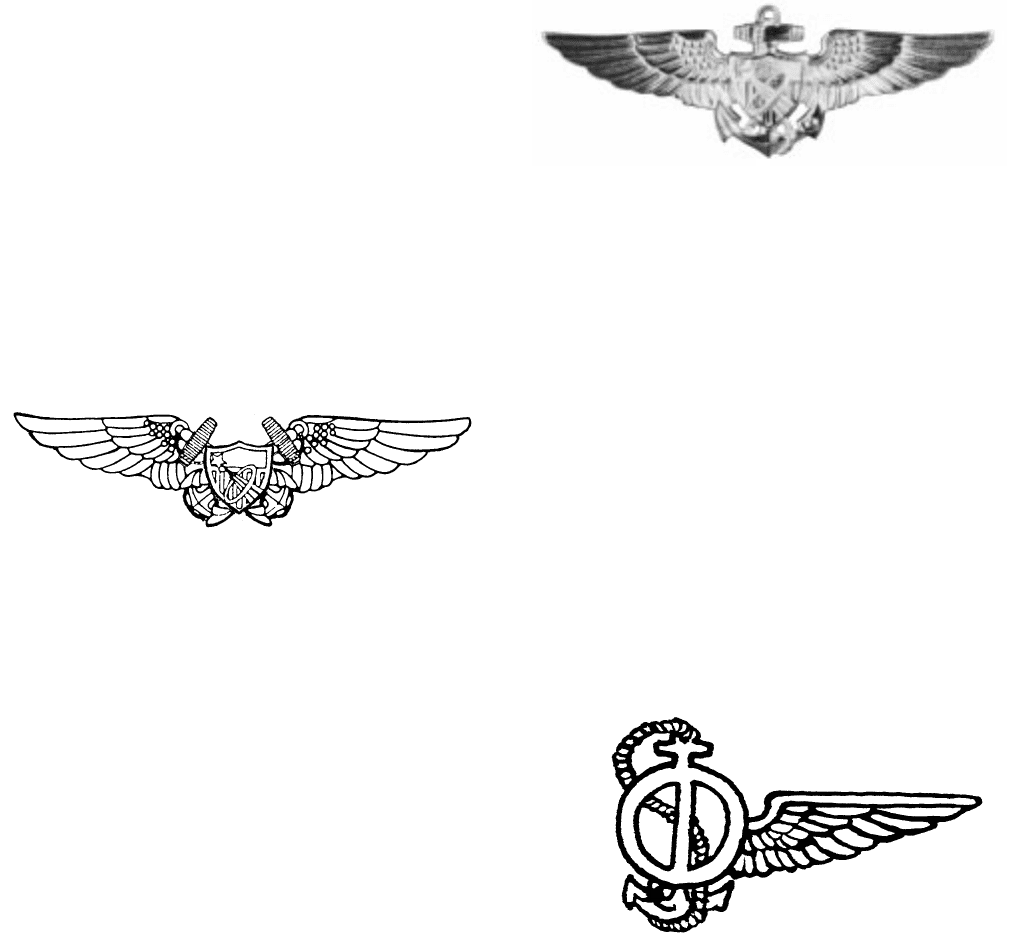
Naval Astronaut (Naval Flight Officer)
Wings
The 1984 Uniform Regulations, issued on 6 February
1984, authorized the wearing of the new Naval
Astronaut (Naval Flight Officer) wings. The regulations
described the wings as follows: “Naval Astronaut
(NFO) Insignia. A gold embroidered or solid gold
metal pin; winged and containing a shooting star with
an elliptical ring surrounding the trailing shafts; super-
imposed diagonally from bottom right to top left, on
the shield of the traditional Naval Flight Officer’s
Wings.”
A Naval Flight Officer or an active duty officer quali-
fied as a Naval Astronaut (Specialist), who is not a
Navy pilot or NFO, may wear the Naval Astronaut
(NFO) Wings if they are designated by the CNO or
Commandant of the Marine Corps after meeting the
following qualifications:
a. Currently on flying status as a Naval Flight Officer
or a payload specialist as a shuttle astronaut (but not
qualified as a Navy Pilot or NFO) in either the Navy,
Marine Corps, or their Reserve components.
b. Trained, qualified, and certified to fly as a mission
or payload specialist in powered vehicles designed for
flight above 50 miles from the earth’s surface.
c. Have completed a minimum of one flight as a mis-
sion or payload specialist aboard an extraterrestrial vehi-
cle in a flight above 50 miles from the earth’s surface.
Naval Pilot may wear the Naval Astronaut (Pilot)
wings upon designation by the CNO or Commandant
of the Marine Corps after meeting the following
qualifications:
a. Currently on flying status as a Naval Pilot in either
the Navy, Marine Corps, or their Reserve components.
b. Trained, qualified, and certified to fly a powered
vehicle designed for flight above 50 miles from the
earth’s surface.
c. Completed a minimum of one flight as a pilot or
mission specialist aboard an extraterrestrial vehicle in
a flight above 50 miles from the earth’s surface.
662 UNITED STATES NAVAL AVIATION 1910–1995
The line drawing shows the Naval Astronaut (NFO) Wings.
Naval Astronaut (Pilot) Wings
The Navy’s first Naval Astronaut (Pilot) wings were
presented to Commander Alan B. Shepard, Jr., on 6
December 1961 by the Chief of Naval Operations
Admiral George W. Anderson. On 18 December 1962,
the Secretary of the Navy officially approved the
Uniform Board’s recommendation to include a de-
scription and photograph of the Naval Astronaut wing
insignia in the 1959 Uniform Regulations. The Naval
Astronaut (Pilot) wings are identical to the Navy Pilot
wings with the addition of a shooting star superim-
posed over the shield. The shooting star symbolized
the astronaut’s spatial environment.
The Naval Military Personnel Manual states the cri-
teria for designation as a Naval Astronaut (Pilot). A
The line drawing is the first Naval Aviation Observer Wing Insignia.
It was used by the Navy from 1922 to January 1927.
The photograph shows the Naval Astronaut (Pilot) Wings that were
first presented in 1961.
Naval Aviation Observer Wings
The Naval Aviation Observer (NAO) designation had
its origin in an act of Congress on 12 July 1921, which
created the Bureau of Aeronautics and provided that
its chief qualify within one year of his appointment as
an “aircraft pilot or observer.” The functions and quali-
fications for an observer were first defined on 27
March 1922; on 17 June of the same year, Rear
Admiral William A. Moffett became the first to qualify
for the designation as a Naval Aviation Observer.
The 1922 Uniform Regulations, approved 20
September, provided that officers designated as Naval
Aviation Observer wear the same insignia as that worn
by Naval Aviators, except with the right wing and
shield removed and an “O” superimposed on the foul
anchor.
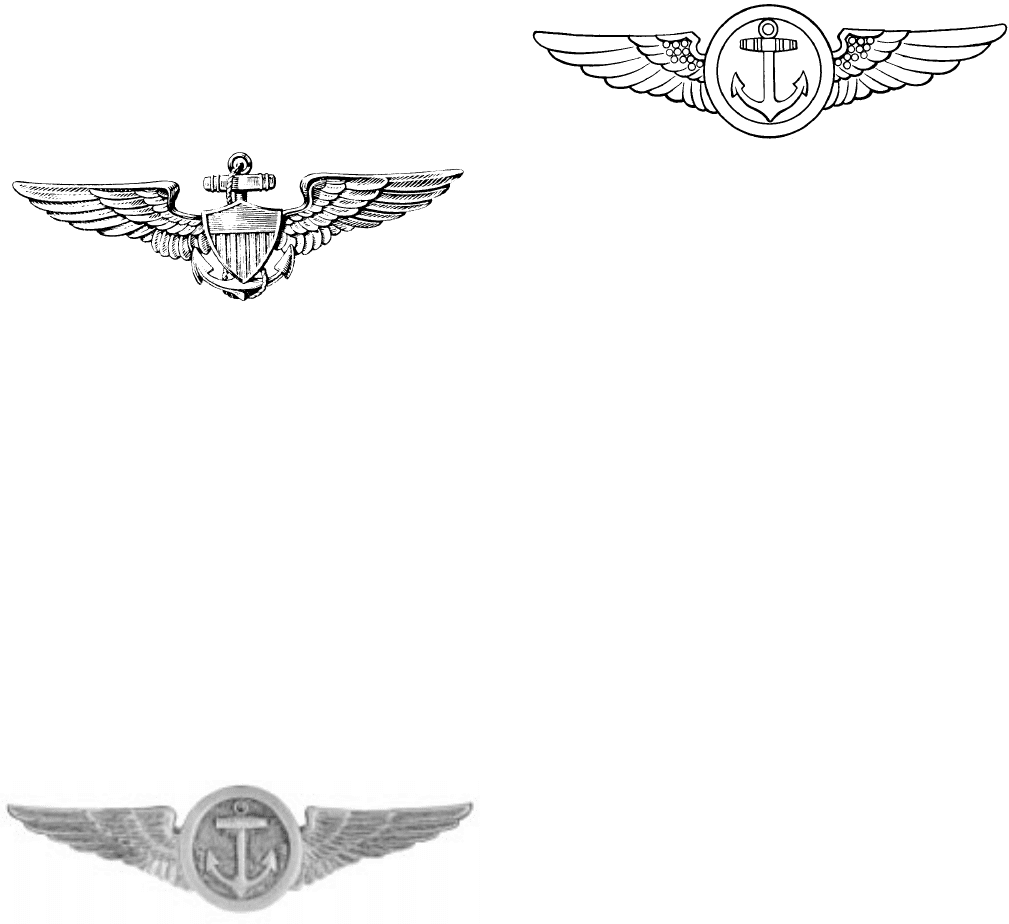
an O circumscribing an erect, plain anchor, both in
silver; the O and the anchor to be in bold relief, the
center of the O being filled with gold. The insignia
shall measure 2
3
⁄40 between wing tips; outer diameter
of O shall be
3
⁄40; inner diameter of O shall be
9
⁄160;
height of anchor shall be
1
⁄20 with other dimensions
proportionate.”
In the 1950s and 1960s, the Naval Aviation Observer
wings were worn by officers who were Radar
Intercept Operators (RIOs), Bombardier/Navigators
(BNs), and Airborne Electronic Countermeasures
Operators (AECMs). They were also worn by enlisted
personnel who were qualified Navigators, Airborne
Electronic Countermeasures Operators, Airborne Radio
Operators, VG Jet Aircraft Flight Engineers and quali-
fied Observers.
On 18 July 1968, the CNO approved a new qualifi-
cation breast insignia for Navy and Marine Corps per-
sonnel designated as Naval Flight Officers (NFOs).
BuPers Notice 1020 of 24 August 1968 issued the
change to the Uniform Regulations (NavPers 15665)
for the new Naval Flight Officer wings: “This new in-
signia will replace the Naval Aviation Observer in-
signia currently worn by Naval Flight Officers and will
be authorized for wear upon source availability. The
Naval Aviation Observer insignia will become obsolete
after 31 December 1968.” This ended the old Naval
Aviation Observer wings for a short period of time.
However, they were destined for continued use by
Naval Aviation.
Naval Aviation Observer and Flight
Meteorologist Wings
On 21 May 1969, the CNO approved the use of the
Naval Aviation Observer wings for wear by Flight
Meteorologists and for those officers formerly entitled
but not selected as Naval Flight Officers. This change
was incorporated into the 1959 Uniform Regulations
by Bureau of Personnel Notice 1020 of 16 June 1969.
The 1969 Uniform Regulations, issued on 17
October 1969, did not mention the Flight
Meteorologist insignia. However, the 1975 Uniform
Regulations, which replaced the 1969 edition, listed
A 26 January 1927 change to the 1922 Uniform
Regulations (Change Number 3) modified the Naval
Aviation Observer design and changed it to the same
insignia worn by Naval Aviators except that it was to
be in silver.
UNITED STATES NAVAL AVIATION 1910–1995 663
Between January 1927 and October 1929 the design of Naval
Aviation Observer Wings was the same as Naval Aviator Wings ex-
cept the observer wings were silver, not gold like the Naval Aviator.
Bureau of Navigation Circular Letter 71-29 of 19
October 1929 (Change Number 7 to the 1922 Uniform
Regulations) directed another change to the Naval
Aviation Observer wings. This letter described the new
design as: “...an insignia the same as for naval aviators
as to gold wings, but that the central device shall be
an ‘O’ circumscribing an erect plain anchor, both in
silver. The ‘O’ and anchor to be in bold relief, the cen-
ter of the ‘O’ being filled in gold.” The 1941 Uniform
Regulations, of 31 May 1941, repeated the previous
description and added dimensions as follows:
“...outer diameter of ‘O’ shall be
3
⁄4 inch, inner diame-
ter
9
⁄16 inch. Height of anchor shall be
1
⁄2 inch.”
This photograph of Naval Aviation Observer Wings is the type that
has been used by the Navy between 1929 to 1968.
The Naval Aviation Observer wings made the same
transition that occurred to the Naval Aviator wings
during World War II. A change to the 1951 Uniform
Regulations, issued on 6 February 1953 as BuPers
Change Memorandum 1-2, directed the wing style
used by the Naval Aviator breast insignia be adopted
for the Naval Aviation Observer insignia. Hence, the
series of dots, or circles were incorporated into the
upper-part of the design where the wings break.
The following is a detailed description of the Naval
Aviation Observer wings from the Uniform Regulations
of 6 April 1959: “A gold embroidered or gold color
metal pin, winged, with a central device consisting of
The Naval Aviation Observer Wings showing the dots in the upper-
part of the wing.

the Naval Aviation Observers and Flight Meteorologist
wings. The 1975 regulations states: “Naval Aviation
Observer and Flight Meteorologist Insignia. A gold em-
broidered or gold color metal pin; winged, with a cen-
tral device consisting of an O circumscribing an erect,
plan anchor, both in silver; the O and the anchor to be
in bold relief, the center of the O being filled with
gold. The embroidered device shall be on a back-
ground to match the color of the uniform on which
worn.”
Qualifications to wear the Naval Aviation Observer
wings, the second oldest wings in the Navy, are out-
lined in the Naval Military Personnel Manual. Although
not aeronautically designated, the following types of
officers are authorized to wear NAO wings upon initial
qualification: Flight Meteorology and Oceanography
Officer; Special Evaluator (officers and warrant officers
from the cryptologic community); Aviation Operations
Limited Duty Officer (632X); Aviation Operations
Technicain Warrant Officer (732X); and other officers
assigned by the Chief of Naval Personnel to duty in-
volving flying as technical observers and airborne
command post crew members.
The Marine Corps authorized the use of the old
Naval Aviation Observer wings for personnel complet-
ing the Naval Aviation Observer School at Marine
Corps Air Station New River. Qualified aerial observers
were to provide commanders with information of in-
telligence value not readily available from normal
ground sources regarding enemy forces; procure infor-
mation concerning terrain, and to supplement opera-
tional information of friendly forces; direct supporting
fires for ground forces to include artillery, naval gun-
fire, and close air support; to perform utility and liai-
son missions as directed from an observation aircraft
and to advise commanders of ground units on matters
pertaining to aerial observation.
See the section on Naval Aviation Observer Wings
for a photograph of the device.
Naval Aviation Observer (Navigation)
Wings
BuPers Circular Letter 88-45 of 31 March 1945 an-
nounced the Secretary of the Navy had approved an
insignia for Naval Aviation Observers (Navigation) on
30 March 1945. It revised the 1941 Uniform
Regulations by adding the following: “Officers desig-
nated as Naval Aviation Observers (Navigation) by the
Chief of Naval Personnel shall wear the following in-
signia: A gold-embroidered or bronze gold-plated
metal pin, winged, with silver center device superim-
posed upon crossed gold-color foul anchors. The cen-
terpiece shall have superimposed upon it, in bold re-
lief and in gold color, one gold disc with eight
intercardinal points of the compass; superimposed
upon this gold disc will be a second disc, in bold re-
lief and in gold color, with four cardinal points and
four intercardinal points of the compass. The insignia
shall measure 2
3
⁄40 from tip to tip of wings; silver cen-
ter device shall be approximately
15
⁄320 in diameter;
crossed foul anchors shall be of a size to be inscribed
in a circle
3
⁄40 in diameter; the inner gold disc shall be
approximately
1
⁄80 in diameter, and the outer gold disc
shall be approximately
1
⁄40 in diameter. Naval Aviators
and Naval Aviation Observers will not wear the Naval
Aviation Observer (Navigation) insignia.”
A Bureau of Naval Personnel letter dated 18 March
1947 abolished the Naval Aviation Observer
(Navigation) insignia and authorized all officers desig-
nated as Naval Aviation Observer (Navigation) to wear
the same insignia as that worn by Naval Aviation
Observers.
664 UNITED STATES NAVAL AVIATION 1910–1995
The photo shows the Naval Aviation Observer (Navigation) Wing in-
signia used by the Navy for the period 1945–1947.
Naval Aviation Observers (Radar)
Wings
The Secretary of the Navy approved the Naval
Aviation Observer (Radar) insignia on 29 August 1945.
BuPers Circular Letter Number 313-45 of 17 October
1945 announced the insignia and a subsequent change
was made to the 1941 Uniform Regulations. The letter
described the wings as follows: “Naval Aviation
Observers (Radar) shall wear a gold embroidered or
bronze gold-platted metal pin, winged, with silver cen-
ter device superimposed upon crossed gold-color foul
anchors. The center piece shall have superimposed
upon it, in bold relief and in gold color, a symbolic
radar manifestation. The insignia shall measure 2
3
⁄40
from tip to tip of wings; silver center device shall be
approximately
15
⁄320 in diameter; crossed foul anchors
shall be of a size to be inscribed in a circle
3
⁄40 in diam-
eter. Naval Aviation Observers (Radar) shall not wear
any other aviation breast insignia.”
A Bureau of Naval Personnel letter dated 18 March
1947 abolished the Naval Aviation Observers (Radar)
insignia, and authorized all officers designated as
Naval Aviation Observers (Radar) to wear the same in-
signia prescribed for Naval Aviation Observers.
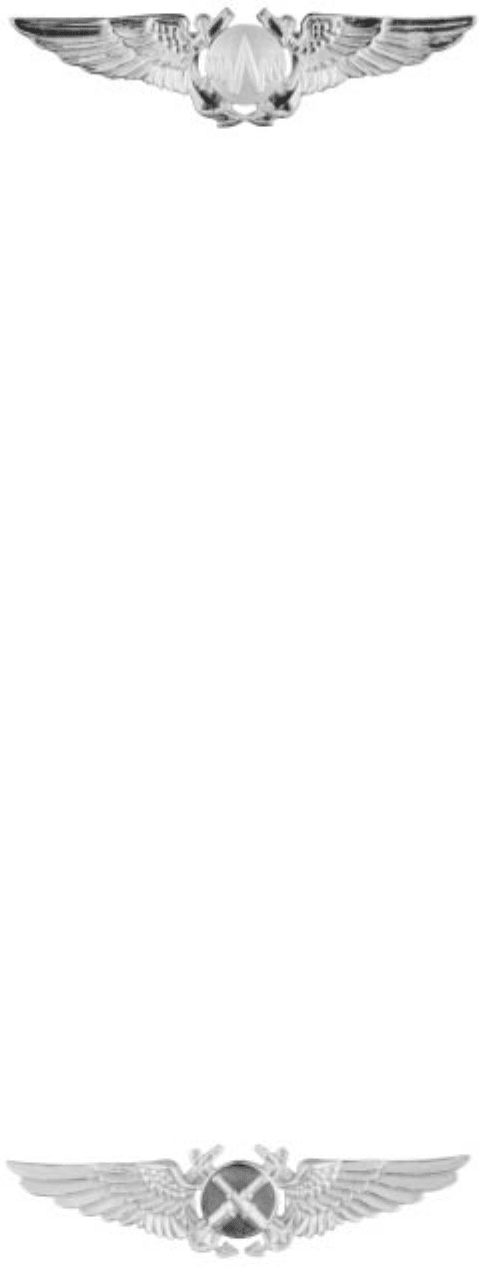
Naval Aviation Observer (Aerology)
BuPers Circular Letter Number 87-47 of 15 May 1947
established the designation Naval Aviation Observer
(Aerology). Besides establishing the qualifications nec-
essary to be designated a Naval Aviation Observer
(Aerology), the circular letter also stated the following:
“Officers designated naval aviation observers (aerol-
ogy) by the Chief of Naval Personnel will be autho-
rized to wear the insignia already established for naval
aviation observers .. . ” BuPers letter (Pers-329-MEB
A2-3) of 24 February 1948 issued Change 1 to the 1947
Uniform Regulations and states: “Naval Aviation
Observer Insignia. Officers who have been designated
as naval aviation observers, Naval Aviation Observers
(Aerology), Naval Aviation Observers (Navigation),
Naval Aviation Observers (Radar), or Naval Aviation
Observers (Tactical) by the Chief of Naval Personnel
shall wear the following insignia: A gold embroidered
or bronze gold-plated metal pin, winged, with a cen-
tral device consisting of an “O” circumscribing an
erect, plan anchor, both in silver; the “O” and the an-
chor to be in bold relief, the center of the “O” being
filled with gold. The insignia shall measure 2
3
⁄40 be-
tween wing tips; the outer diameter of the “O” shall be
3
⁄40, the inner diameter
9
⁄160; height of anchor shall be
1
⁄20. The embroidered device shall be on a background
to match the color of the uniform.” See the Naval
Aviation Observer Wing section for a photograph of
the Naval Aviation Observer Wing.
Naval Flight Officer Wings
On 8 February 1965, a change to Bureau of
Personnel Instruction 1210.4C authorized a new desi-
gantor and name, Naval Flight Officer (NFO). The new
designator was appropriate for “an unrestricted line of-
ficer, a member of the aeronautical organization . . .
who may fill any billet not requiring actual control
knoweldge of an aircraft.” Eight subspecialties were
available at the time: bombardier, controller, electronic
countermeasures evaluator, navigator, interceptor, pho-
tographer-navigator, tactical coordinator and recon-
naissance navigator. The new NFOs continued wear-
ing the Naval Aviation Observer wings.
On 18 July 1968, the CNO approved a new qualifi-
cation breast insignia for Navy and Marine Corps per-
sonnel designated as Naval Flight Officers (NFOs).
BuPers Notice 1020 of 24 August 1968 changed the
Uniform Regulations (NAVPers 15665). The notice
stated: “This new insignia will replace the Naval
Aviation Observer insignia currently worn by Naval
Flight Officers and will be authorized for wear upon
source availability. The Naval Aviation Observer in-
signia will become obsolete after 31 December 1968.”
In this change to the Uniform Regulations (NAVPERS
Naval Aviation Observers (Tactical)
Wing
On 19 January 1946, the Secretary of the Navy ap-
proved the Naval Aviation Observers (Tactical) wings
for Navy and Marine Corps officers performing duty
as gunfire and artillery spotters and general liaison
operations. A BuPers Circular Letter Number 28-46 of
5 February 1946 changed the 1941 Uniform
Regulations to reflect that Naval Aviation Observers
(Tactical) would wear a device similar to the Naval
Aviation Observer (Navigation) insignia except “the
centerpiece shall have two crossed guns superim-
posed upon it, in bold relief and in gold color.” The
PuPers letter provided the following description:
“Naval Aviation Observers (Tactical) shall wear a
gold embroidered or bronze gold-plated metal pin,
winged, with silver center device superimposed
upon crossed gold-color foul anchors. The center
piece shall have two crossed guns superimposed
upon it, in bold relief and in gold color. The insignia
shall measure 2
3
⁄40 from tip to tip of wings; silver
center device shall be approximately
15
⁄320 in diame-
ter; crossed foul anchors shall be of a size to be in-
scribed in a circle
3
⁄40 in diameter and the crossed
guns shall be of a size to be inscribed in a circle
13
⁄320
in diameter.”
A Bureau of Naval Personnel letter dated 18 March
1947 abolished the Naval Aviation Observers
(Tactical) insignia and authorized all officers desig-
nated as Naval Aviation Observers (Tactical) to wear
the same insignia prescribed for Naval Aviation
Observers.
UNITED STATES NAVAL AVIATION 1910–1995 665
The photograph shows the Naval Aviation Observers (Radar) Wing
insignia used by the Navy for the period 1945–1947.
The photograph shows the Naval Aviation Observers (Tactical) Wing
insignia used by the Navy for the period 1946–1947.

15665) all references to Naval Aviation Observers were
changed to Naval Flight Officer. Article 0157.2d. of the
Uniform Regulations read: “Naval Flight Officer
Insignia. A gold embroidered or gold color metal pin;
winged, with a central device consisting of a shield su-
perimposed on a set of small, crossed, fouled anchors.
The embroidered device shall be on a background to
match the color of the uniform on which worn.”
The Naval Flight Officer wings were approved to
General qualifications for wearing the Navy and
Marine Corps Parachutist Wings were:
(1) Have previously qualified for the Basic Para-
chutist insignia by completing formal parachutist train-
ing at an Armed Services installation.
(2) Have completed a minimum of five additional
parachute jumps, under competent orders, with a
Navy or Marine Corps organization whose mission in-
cludes parachute jumping.
Once a person qualified for the Navy and Marine
Corps Parachutist insignia it will be worn in lieu of the
Basic Parachutist insignia.
666 UNITED STATES NAVAL AVIATION 1910–1995
The photograph shows the Naval Flight Officer wings approved in 1968.
keep pace with the changes to the designators and
new titles for personnel that had been designated
Naval Aviation Observers. Flight officers are more
closely aligned with pilots as opposed to meteorolo-
gists and other scientists. Also, the flying officer/crew-
men were line officers who were allowed to compete
for and earn any command assignment for which they
qualify by demonstrated performance and ability, with
the exception of a billet that required actual control
knowledge of an aircraft. Hence, Naval Flight Officers
were line officers who could qualify for command of a
ship or carrier or commanding officer of a squadron
just like Naval Aviators.
Navy and Marine Corps Parachutist
Wing Insignia
BuPers Notice 1020 of 12 July 1963 issued informa-
tion on a change to the 1959 Uniform Regulations
concerning the adoption of a new wing insignia for
Navy and Marine Corps Parachutists. This notice
stated: “The old parachutist insignia. . . shall be re-
named the ‘Basic Parachutist Insignia’ in conformance
with the Army and Air Force nomenclature. The sub-
ject insignia shall be referred to as the ‘Navy and
Marine Corps Parachutist Insignia’.” The description of
the insignia was as follows: “A gold embroidered
(Navy only) or gold-colored metal pin, same as that
provided for Naval Aviator’s insignia, except that a
gold-colored open parachute shall be centered on the
wings vice the shield and foul anchor; width of the
wings from tip to tip shall be 2
3
⁄40; width of the
parachute
1
⁄20 at the widest part; length of the
parachute from top to bottom
13
⁄160.”
The photograph shows the Navy and Marine Corps Parachutist in-
signia approved in 1963.
Basic Parachutist Wing Insignia
The first mention of a parachutist designation and
qualification badge is found in a change to the 1941
Uniform Regulations issued by a BuNav Circular Letter
Number 51-42 of 31 March 1942. The circular letter
stated: “The following Parachute Regulations, having
been approved by the Secretary of the Navy on 6
February 1942, are published herewith for the infor-
mation of all concerned:
1. (2) DESIGNATION: The designation (ratings) of
‘Parachutist’ and ‘Student Parachutist’ are hereby estab-
lished for officers, warrant officers, and enlisted men
of the Navy and Marine Corps of the United States,
which designations (ratings) shall be in addition to
such military or Naval ratings or ranks as are now or
may hereafter be authorized by law.
(5) RETENTION OF DESIGNATION AS PARA-
CHUTIST OR STUDENT PARACHUTIST: An officer,
warrant officer or enlisted man of the Navy . . . who
has attained a designation (rating) as a parachutist or
student parachutis . . . provided, that officers, warrant
officers, and enlisted men . . . who have been desig-
nated as parachutists pursuant to these regulations are
authorized to retain permanently and to wear such
qualification badge as parachutists as may be pre-
scribed by competent authority.”
However, the Secretary of the Navy did not autho-
rize the parachutist badge, even though the above
change to the 1941 Uniform Regulation references the
wearing of such a qualification badge. There is no de-
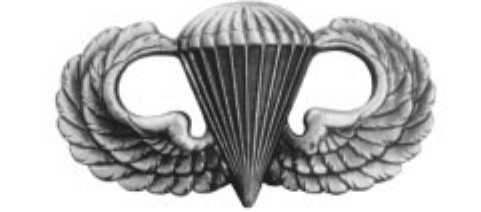
parachutist insignia . . . shall be renamed the ‘Basic
Parachutist Insignia’ in conformance with the Army
and Air Force nomenclature.”
scription of a parachutist insignia until January 1947. A
BuPers letter (Pers-329-MEB A2-3) of 17 January 1947
issued changes to the 1941 Uniform Regulations as ap-
proved by the Secretary of the Navy. This letter states:
“(j) A parachutist insignia, enclosure (B), has been au-
thorized for enlisted personnel who have been desig-
nated as parachutists in accordance with the Bureau of
Naval Personnel Manual. This insignia is the same as
the parachutist insignia authorized by the Marine
Corps and the Army. 2. The wearing of the parachutist
insignia, enclosure (B), by officers and warrant officers
who have been designated as parachutists in accor-
dance with the Bureau of Naval Personnel Manual has
also been authorized. Pending a revision of Chapters
II and III, U.S. Navy Uniform Regulations, 1941, offi-
cers and warrant officers who are eligible to wear the
parachutist insignia may do so under similar regula-
tions contained in Art. 8-8 of enclosure (A).” A 14
February 1947 letter from BuPers issued the new
Chapter II to the 1941 Uniform Regulations and in-
cluded the parachutist insignia.
The 1951 Uniform Regulations described the
Parachutist insignia as follows: “An open parachute, in
silver, flanked on each side by wings, curved upward;
the device to be 1
1
⁄20 wide and
3
⁄40 high.” A BuPers
Notice 1020 of 12 July 1963 issued information on a
change to the 1959 Uniform Regulations concerning
the adoption of a new wing insignia for Navy and
Marine Corps Parachutists. This notice stated: “The old
UNITED STATES NAVAL AVIATION 1910–1995 667
Photograph of Basic Parachutist insignia.
Marine Aerial Navigator Wing
In June 1976, the Marine Corps approved the use of
the old World War II Naval Aviation Observer
(Navigation) wings for use by Marine Corps personnel
who qualified as Marine Aerial Navigators. See the sec-
tion on Naval Aviation Observer (Navigation) wings
for a description and photograph of the wings.
Marine Aerial Observer Wing
See the section on Naval Aviation Observer and
Flight Meteorologist Wings. These are the wings worn
by Marine Aerial Observers.
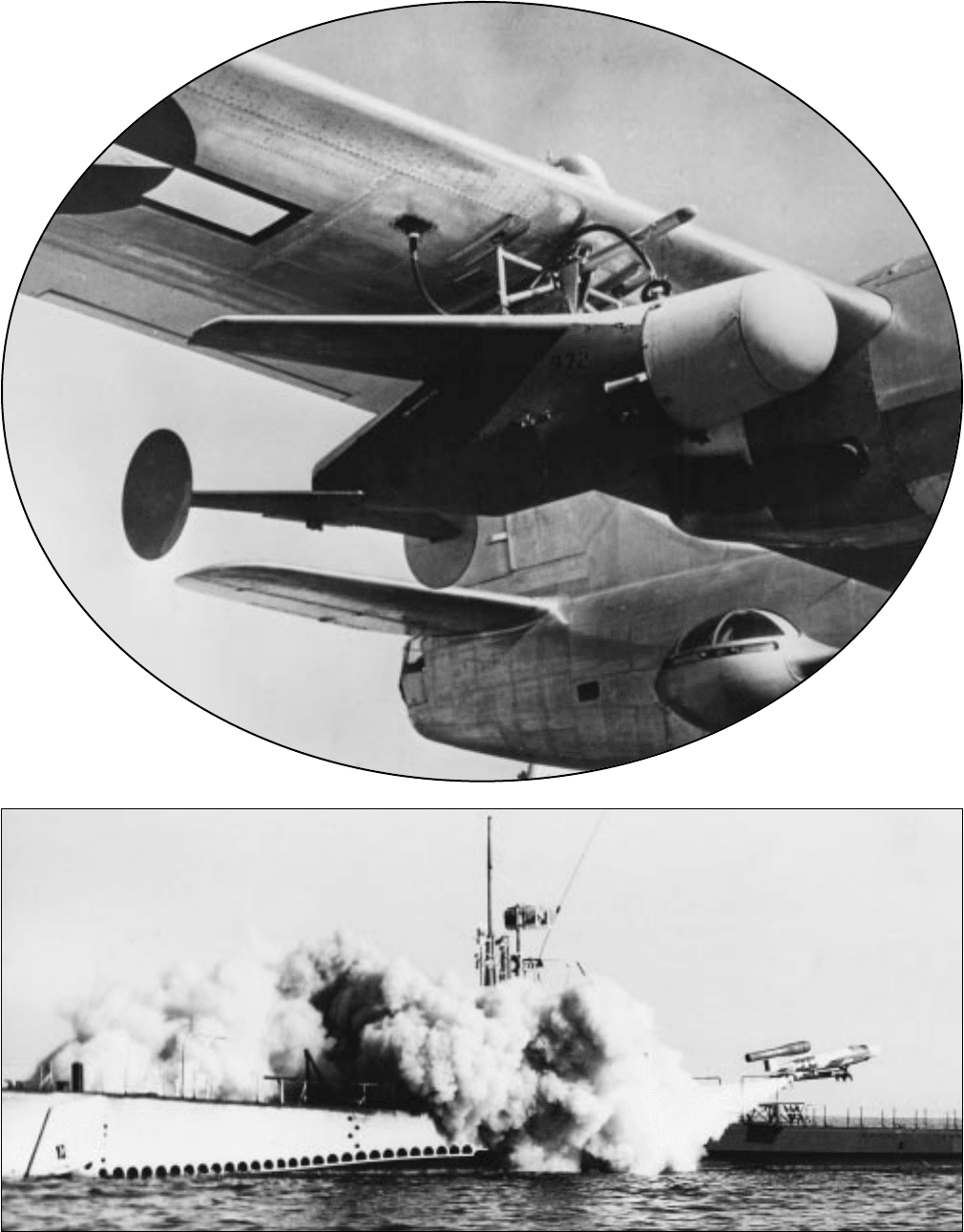
668 UNITED STATES NAVAL AVIATION 1910–1995
A Bat missile on the wing
of a Navy Privateer, USN-
701606.
A Loon missile being launched from Carbonero (SS 337), USN-402800.

New and Old
Model Designation Manufacturer Popular Name Description
—— Bristol Siddeley Corp/LTV Jindivik Guided missile target drone
—— —— Glimps ASW pilotless plane, released from blimps,never used
AQM-34B/KDA-1 Ryan Firebee Subsonic target drone
AQM-34C/KDA-4 Ryan Firebee Subsonic target drone
AQM-37A/KD2B-1 Beech Challenger Air-launched supersonic target missile
AQM-37C Beech Jayhawk Supersonic missile target
AQM-38B/RP-78 Northrop Ventura —— Army contract, missile target
AQM-127 LTV Corp. SLAT Supersonic low-altitude target
AQM-81B Teledyne Ryan Firebolt A Navy modified AQM-81A target missile
BQM-6C/KDU-1 Chance Vought —— BuAer managed,target drone version of Regulus I
BQM-34E/KDA series Ryan Firebee II Navy version of BQM-34A,supersonic target drone
BQM-34S Ryan Firebee II Upgraded BQM-34E with integrated target control
BQM-34T Ryan Firebee II BQM-34E modified with transponder set and autopilot
BQM-74C Northrop Chukar III Recoverable,remotely controlled,gunnery target
BQM-74E Northrop —— Subscale,subsonic aerial target drone
BQM-126A Beech —— Variable speed target missile
BQM-145A Teledyne Ryan Peregrine Reconnaissance drone
BQM-147A RPV Industries —— Remotely/automatically piloted vehicle
CQM-10A NAVAIR BOMARC Converted Air Force weapon system to missile target
DSN/QH-50C Gyrodyne DASH Remotely controlled ASW helicopter
F.B./N-9 —— Flying Bomb N-9 configured as a Flying Bomb
F.B. Sperry-Curtiss Flying Bomb
F.B. Witteman-Lewis Flying Bomb
KAQ Fairchild Engine & A/c Co. —— Pilotless aircraft
KAY Consolidated Vultee A/c Co. —— Ship-to-air pilotless aircraft
KDA-1(BQM-34 series) Ryan Firebee I Target aircraft
KDB (see MQM-39A) Beech ——
KDC-1 Curtiss-Wright Corp. —— Mid-wing monoplane target,not procured
KDD-1 (see KDH-1) McDonnell Katydid
KDG-1 Globe Snipe Mid-wing monoplane for gunnery practice
KDG-2 Globe Snipe Similar to KDG-1 except for 24 volt system
KDH-1/TD2D-1/KDD-1 McDonnell Katydid Remotely controlled aerial target
KDM-1 Martin Plover High wing air launched,development of PTV-N-2
KDR-1/TD4D-1 Radioplane Quail Similar to TD3D-1,Army model OQ-17
KDR-2 Radioplane Quail Similar to KDR-1 except structural changes
KDT-1 Temco —— Solid propellant rocket-powered drone
KDU-1 —— —— Target drone for guided missile evaluation firings
KD2C-1 Curtiss-Wright Corp. Skeet Pilotless aircraft target drone
KD2G-1 Globe Firefly Mid-wing, all metal,twin tail, monoplane target
KD2G-2 Globe Firefly Similar to KD2G-1
KD2N-1 NAMU —— High mid-wing monoplane,canard design
KD2R-1 Radioplane Quail Wooden wings, metal monocoque fuselage target drone
UNITED STATES NAVAL AVIATION 1910–1995 669
669
APPENDIX 21
List of Naval Aviation Drones
and Missiles
Pilotless Aircraft/Drones/Targets/Remotely Piloted Vehicles

KD2R-2 Radioplane Quail Similar to KD2R-1 except 28 volt radio & stabilized
KD2R-2E Radioplane Quail KD2R-2 modified system for test at NAMTC
KD2R-3 Radioplane Quail Similar XKD2R-4 except engine & C-2A stabilization
KD2U Chance Vought Corp. —— Conversion Regulus II to supersonic drones
KD3G-1 Globe Snipe Same as KDG-1 except for engine
KD3G-2 Globe Snipe Same as KD3G-1 with radio control receiver 28 volt
KD4G-1 Globe Quail High all metal wing gunnery trainer
KD4G-2 Globe Quail Similar to KD4G-1 except engine and higher speed
KD4R-1 Radioplane —— Rocket propelled target drone
KD5G-1 Globe —— High wing and twin tail aircraft target
KGN/KUN NAMU —— High wing monoplane,canard design target drone
KGW/KUW —— —— Pilotless aircraft
KSD/KUD —— —— Pilotless aircraft
KU2N-1/KA2N-1 NAMU —— High midwing monoplane, canard design,liquid rocket
KU3N-1/KA3N-1 NAMU —— High midwing monoplane, conventional, liquid rocket
KU3N-2/KA3N-2 NAMU —— Similar to KU3N-1
KUD-1/LBD-1/KSD-1/BQM-6C McDonnell Regulus I BuAer managed, target drone version of Regulus I
KUM Glenn Martin Company —— Pilotless aircraft for testing ram jet power plant
KUN-1/KGN-1 NAMU —— High wing monoplane, canard design target drone
LBE-1 Gould/Pratt-Read & Co. Glomb Expendable bomb-carrying guided assult glider
LBP Pratt-Read & Co. Glomb Was scheduled for development.
LBT-1 Taylorcraft Glomb Expendable bomb-carrying guided glider
LNS-1 Schweizer Glomb Glider test vehicle for Glomb
LNT-1 Naval Aircraft Factory Glomb Assault glider television controlled
LRN-1 Naval Aircraft Factory Glomb Large explosive carrying glider
LRW-1 —— Glomb Test vehicle for Glomb
MQM-8 Bendix Aerospace Vandal/Vandel ER Reconfigured Talos for simulating cruise missile
MQM-15A/KD2U-1 Chance Vought Regulus II BuAer program, conversion Regulus II to target drone
MQM-36A/KD2R-5 Northrop Ventura —— Small propeller driver target drone
MQM-39A/KDB-1 Beech ——
MQM-61A Beech ——
MQM-74C Northrop Chukar II Turbojet, remotely controlled drone,target training
RP-78 Northrop Ventura —— Army contract,missile target
RPV AAI Corp. Pioneer Remotely Piloted Vehicle with television camera
TD2C-1 Culver Turkey Target drone for aircraft and anti-gunnery training
TD2D-1/XTD2D-1 McDonnell —— Remotely controlled aerial target, RESO-JET powered
TD2N-2/TD3N-1 NAF/NAMU —— Target aircraft
TD2R Interstate —— Assault drone, program dropped
TD3C-1 Culver —— Target drone for aircraft and anti-aircraft training
TD3D-1 Frankfort Sailplane Co. —— Target drone,similar to TDD-3,Army model OQ-16
TD3N-1 NAF —— Target aircraft
TD3R-1 Interstate —— Torpedo carrying remote-controlled assault drone
TD4D-1 Radioplane —— Target drone,Army model OQ-17
TDC-2 Culver Air —— Target drone
TDD-1/2/3 Radioplane/Globe Denny Remotely controlled aerial target, gunnery practice
TDD-4 Radioplane/Globe Denny Same as TDD-3 except for engine
TDN Naval Aircraft Factory —— World War II assault drone
TDR Interstate —— World War II assault drone
XBDR-1 Interstate —— WW-II jet powered,television directed assault drone
XBQ-3 Fairchild Corp. —— Assault Drone,Army Air Corps controllable bomb
XKD3C-1 Curtiss —— Similar to KD2C-2 with engine change, no rudder
XKD6G-1 Globe —— Similar to KD2G-2,except for engine,new fuselage
670 UNITED STATES NAVAL AVIATION 1910–1995
Pilotless Aircraft/Drones/Targets/Remotely Piloted Vehicles—Continued
New and Old
Model Designation Manufacturer Popular Name Description
